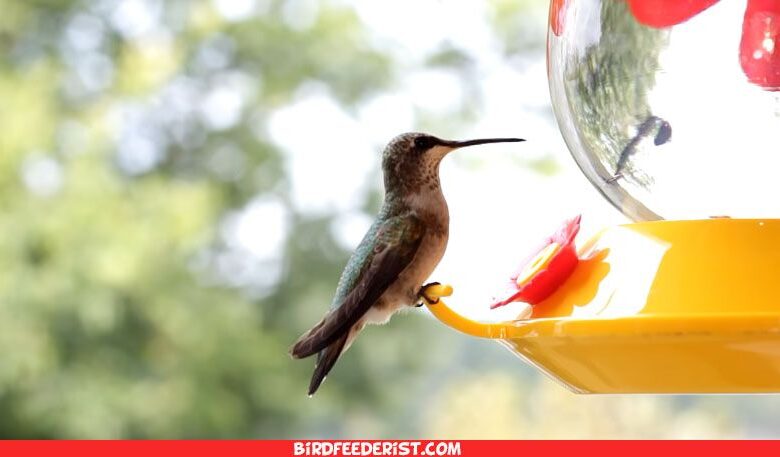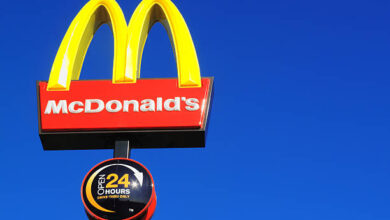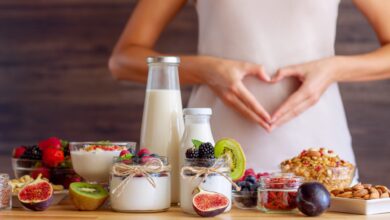
If you’re interested in attracting beautiful hummingbirds to your yard, one of the best ways to do so is by providing them with a steady supply of hummingbird food. Making your own hummingbird food is simple, cost-effective, and ensures that the nectar you’re offering is free of harmful additives or preservatives. In this blog post, we’ll cover everything you need to know about how to make hummingbird food at home.
Understanding the Hummingbird’s Diet
Hummingbirds are fascinating creatures with a diet that is remarkably specialized to meet their high-energy needs. These tiny birds consume nectar from flowers as their primary source of energy. The sugar found in nectar is crucial for fueling their rapid flight and high metabolism. Nectar essentially acts as a powerful energy drink for hummingbirds, giving them the instant burst of energy required for their high-speed wing flaps, which can exceed 50 flaps per second.
- In addition to nectar, hummingbirds also incorporate protein into their diet, which they obtain from consuming small insects and spiders. This aspect of their diet is vital for their overall health, supporting muscle maintenance, feather growth, and more. It’s a common misconception that hummingbirds solely rely on nectar; while it is their main energy source, the protein from insects and spiders balances their diet, aiding in their growth and reproductive health.
- When replicating a hummingbird’s natural nectar source at home, the goal is to mimic the sugar concentration found in wildflowers, which is why a simple sugar and water solution is recommended. This not only provides them with the essential energy they need but also encourages them to visit your feeder as an additional food source without detracting from their natural foraging habits.
- It’s worth noting that while hummingbirds are attracted to the color red, suggesting a preference for red flowers in the wild, this does not mean that food coloring or dyed nectar is necessary or recommended in homemade nectar. The aim is to create a safe and natural dietary supplement for them, not to alter the nutritional content or add potentially harmful substances to their diet. By focusing on creating a balanced, clean, and safe feeding environment, enthusiasts can enjoy the beauty of these birds without compromising their health or natural behaviors.
The Basic Recipe for Homemade Hummingbird Food
Crafting the perfect homemade Hummingbird Food requires nothing more than water and plain white granulated sugar. The simplicity of these ingredients ensures that you’re providing a natural and safe food source, closely resembling the nectar that hummingbirds derive from flowers. To prepare the mixture, combine 1 part sugar with 4 parts water. Begin by boiling the water to ensure any bacteria or impurities are eliminated, then stir in the sugar until it’s completely dissolved. Once the mixture has cooled to room temperature, it’s ready to be placed in your feeders.
- This ratio of sugar to water strikes the ideal balance, offering the birds a source of energy that mirrors the concentration of sugars found in their natural feeding habitats. It’s essential to stick to this ratio to prevent any potential health issues for the hummingbirds, as overly concentrated solutions can interfere with their hydration and energy levels, while too dilute solutions may not provide enough energy.
- The use of plain white sugar is crucial in this recipe. Other sweeteners, including natural alternatives like honey, or other sugar types such as brown sugar, can introduce risks to hummingbirds. These can range from bacterial growth to improper nutrient absorption. White sugar, due to its purity and similarity to the natural sucrose found in flower nectar, is the safest and most beneficial choice.
- After preparing the nectar, ensure it’s completely cooled before filling your feeders. Any excess can be stored in the refrigerator for up to a week, ready for the next refill. This homemade solution is a straightforward and effective way to attract hummingbirds, providing them with the vital energy they need while avoiding the pitfalls of commercial nectars that may contain preservatives or artificial coloring.
Why Plain Sugar Water is Best
Choosing plain sugar water for your hummingbird feeders offers a simple yet effective way to nourish these fast-moving birds. This mixture best replicates the sucrose-rich nectar that hummingbirds naturally seek out in the wild, providing them with a clean, reliable energy source. By adhering to a formula of 1 part sugar to 4 parts water, the resulting solution closely matches the sugar concentration found in many of the flowers hummingbirds are attracted to. This balance is critical for supporting their high-energy needs without disrupting their delicate metabolic processes.
- Opting for plain sugar water over commercial mixes or alternative sweeteners has significant benefits. Commercial nectars often contain unnecessary additives, such as preservatives and artificial colors, that do not benefit the birds and may even pose health risks. Similarly, alternative sweeteners, including honey and organic sugars, can ferment more quickly and harbor bacteria harmful to hummingbirds. By sticking to plain white granulated sugar, you avoid introducing these risks, ensuring that the hummingbirds receive nutrition that’s as safe as it is beneficial.
- Moreover, the absence of artificial coloring in homemade nectar solutions highlights an important consideration for the well-being of hummingbirds. While the red hue of feeders can effectively attract these birds, adding dye to the nectar itself is unnecessary and potentially harmful. The natural attraction to the feeder’s color, coupled with the energy-rich, safe feeding solution you’ve provided, will keep the hummingbirds coming back to your garden without exposing them to the risks associated with colored nectar.
- In summary, plain sugar water stands out as the ideal choice for hummingbird food due to its simplicity, safety, and nutritional fidelity to natural nectar sources. This approach not only attracts hummingbirds to your garden but does so in a manner that prioritizes their health and well-being.
Safe Storage and Preparation Practices
Ensuring the cleanliness and safety of your hummingbird feeders is crucial for the health of these delightful visitors. Regular maintenance of the feeders is key to preventing the growth. Of mold and bacteria, which can be detrimental to hummingbirds. It is recommended to clean the feeders with a solution of one part white vinegar to four parts water, a natural and effective cleaning method. Avoid using soap or harsh chemicals, as these can leave harmful residues. After scrubbing the feeder thoroughly with a brush to remove any mold or residue, rinse it well with plain water before refilling with the fresh nectar.
- When it comes to storing leftover hummingbird food, it’s important to keep it in a clean, airtight container in the refrigerator. This helps to slow down fermentation and bacterial growth, ensuring that the nectar remains fresh and safe for the birds. If you notice any cloudiness or signs of spoilage in the stored nectar, discard it immediately and prepare a fresh batch. Proper storage practices not only extend the life of the hummingbird food but also contribute to the overall health and well-being of your feathered guests.
- Additionally, regularly check the feeders for signs of wear and tear or contamination. If a feeder is damaged or proves difficult to clean thoroughly, it may be time to replace it. Keeping the feeding area clean and well-maintained not only attracts more hummingbirds. But also provides a safer environment for them to enjoy their meals. By implementing these safe storage and preparation practices. You can ensure that your garden remains a favorite stop for these mesmerizing creatures.
Timing and Placement of Your Hummingbird Feeders
The success of attracting hummingbirds to your garden often hinges on the strategic timing and placement of your feeders. To catch the attention of early migratory hummingbirds, set up your feeders by mid to late March. Keeping feeders out until late fall accommodates late migrators and those preparing for the journey south. The ideal placement of hummingbird feeders is in a location that provides both sun and shade throughout the day. This ensures the nectar remains fresh while offering birds a comfortable feeding environment.
- Choose spots near vibrant flowers to enhance the area’s appeal to hummingbirds. But avoid overly windy areas that could cause the feeders to swing or spill. Hang feeders at least four to five feet off the ground to deter. Predators and position them out of reach from household pets. Placing feeders near windows can offer excellent viewing opportunities, but ensure they are either. Very close (less than 3 feet) or quite far (greater than 10 feet) to prevent window strikes.
- Remember, visibility is key for hummingbirds to locate the feeders, so areas free from dense foliage or obstructions can help attract more visitors. By considering these timing and placement tips, you can create a welcoming and safe environment for hummingbirds to thrive in your garden.
Observing and Enjoying Your Hummingbird Visitors
Observing and enjoying your hummingbird visitors can transform your garden into. A tranquil retreat and offer a fascinating glimpse into the world of these tiny, energetic birds. To maximize your viewing pleasure, place your hummingbird feeders in locations. That are easily visible from your windows or outdoor seating areas.
- Keep a pair of binoculars handy for a closer look at their rapid wing movements and iridescent feathers. Creating a quiet, still environment by minimizing sudden movements and noise can encourage. Hummingbirds to linger longer at your feeders, providing you with ample opportunity to observe their behaviors. Engage with a local birdwatching group or online community to share experiences and tips on attracting and observing hummingbirds.
- Such communities can be a treasure trove of information and offer a sense of connection with fellow enthusiasts. Consider keeping a journal to note the different species that visit your garden. Their feeding times, and any interesting behaviors you observe. This can enhance your understanding of hummingbird habits and contribute to a greater appreciation of these remarkable birds. Watching hummingbirds can be a relaxing and rewarding hobby, offering moments of joy and wonder right in your backyard.
Conclusion
In summary, creating homemade hummingbird food is a simple yet. Deeply rewarding way to attract these vibrant birds to your garden. By following the basic recipe of 1 part sugar to 4 parts water, you provide a safe and nutritious. Source of energy that mimics the natural nectar hummingbirds would find in the wild. Ensuring the cleanliness of feeders and practicing safe storage and preparation. Methods are key to keeping your feathered visitors healthy and happy. Additionally, the strategic timing and placement of feeders can significantly enhance. Your chances of attracting and observing these fascinating creatures in your own backyard. By engaging with the process and observing the delightful antics of hummingbirds. You not only contribute to their well-being but also gain a closer connection to the natural world. Embrace the opportunity to create a welcoming haven for hummingbirds. And enjoy the beauty and wonder they bring to your garden.





